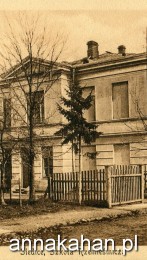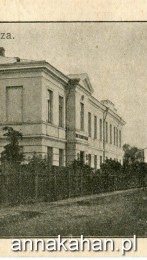[The School of Arts and Crafts]
Let us start a short story about the School of Arts and Crafts with a digression. On Saturday, March 25, 1916, Anna Kahan and her family went to the compulsory vaccination against chickenpox. However, the waiting list was very long. Only a few days later, on Tuesday, March 28, Anna could undergo vaccination. Although she did not write in which hospital the vaccination took place, it can be determined with a high probability.
During this time, only three doctors cared for the health of the residents of Siedlce. If necessary, the injured and sick could count on the help of Eugeniusz Wiszniewski, the chief doctor of the Saint Mary’s hospital, doctor Maria Rytel, the head of the department of internal medicine of this hospital, and doctor Maurycy Sztein, the chief doctor of the Jewish hospital. At the end of partitions, another six doctors were either appointed in the role of military doctors to the Tsarist army or they were evacuated before the upcoming German troops into the depths of Russia. The Russians deprived the Saint Mary’s hospital of auxiliary health care staff. It made the work more difficult as large number of wounded soldiers of Russian, Austrian, and German armies were brought to the hospital. Less injured patients were directed to the Jewish hospital, which did not have a surgical department.
Infectious diseases began to spread at the beginning of the occupation. The overall poor hygiene and the lack of soap in particular created a health hazard. As a result, typhus, chickenpox and lice started to spread. In order to prevent and eliminate the risk, the delousing procedure of the seats of the institutions, individual houses and people was carried out. There were also attempts of delousing on a large scale, but for technical reasons it was not likely to succeed.
On September 8, 1915, the Germans issued the regulation of compulsory vaccination against the chickenpox. However, the threat was still not over. Cases of typhus were also noted. Consequently, in March 1916, the occupiers ordered revaccination against chickenpox. It had to be carried out within a few days, so the city was divided into seven districts. A part of the School of Arts and Crafts was converted into a hospital, which was responsible for vaccinations. Because the building was located close to Anna Kahan’s home, here she was probably vaccinated against the dangerous disease.
Nowadays, the building of the former School of Arts and Crafts belongs to the Stanisław Staszic Secondary School Complex No.1 located at Konarski Street, and is commonly known as the “electrician”.
We enter the park. Strolling along the paths, we should remember that for Anna Kahan and her friends it was a favourite place for walks.



